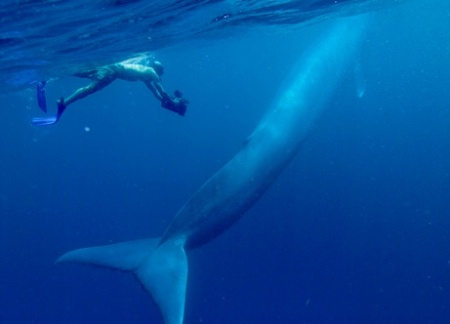1182
27 facts about whales

Whales belong to the order Cetacea, they are mammals, which are fully adapted to aquatic life. It is believed that whales, dolphins and porpoises have evolved from land animals that are returned to an aqueous environment of about 50 million years ago, lived millions of years before the earth.
There are two suborder of whales: toothed and baleen. Toothed whales prey on large fish in deep waters. This is their main source of food. A baleen are essentially live filters that filter using interdigitated mouth large amount of water. They feed on small organisms such as krill and plankton.
Due to the fact that whales, like dolphins, just need to occasionally rise to the surface to breathe, only half of their brain can sleep at a certain time.
Most etymologists believe that the English word "kit» (whale) is derived from the German word «hwal». But it is possible that it may also be derived from the old English word "wheel» (wheel), because the back surface whale very similar with most submerged wheel.
As mammals, whales and the temperature of the warm-blooded body, similar to the human body temperature. In cold water the whales maintain their body temperature due to the thick layer of fat under the skin. This layer protects the internal organs from hypothermia.
Whales and other cetaceans animals move through the water, plunging vertical movements of its tail up and down. This action sets them apart from the fish that during swimming move their fins from side to side.
The blue whale is the largest of all whales and is also considered the largest animal that has ever existed in the world. An adult blue whale sometimes reach up to 108 feet (33 meters) in length and can weigh about 200 tons.
Sperm whales can dive to a depth of 3, 5 kilometers under water. Their bodies have unique physiological properties for adaptation, to enable them to survive in the cold and to withstand high water pressure. They limit the brain and other vital organs. For example, slow the heart to 10 beats per minute to save oxygen and compressed lungs in the chest to withstand water pressure.
Before the invention of deep-sea submarines one of the sources of information about the mysterious depths of the ocean was the examination of the stomach contents of sperm whales. Sperm whales dive to a depth of more than 3 kilometers to search for squid, but quickly returned to the surface to replenish air.
Whales do not drink seawater, instead, they derive water from the food by fat metabolism.
Scientists still do not know why sometimes whales jumping out of the water. The ancient whalers thought the way they tease the fishermen, but biologists have suggested that this is just a demonstration of endurance and strength over other whales.
Baleen whales use natural sonar to communicate with each other, emitting low frequency sounds, which can spread over great distances underwater. Bass sounds made by baleen whales, it seems natural loudest noise of all the animals.
Whales do not have enemies among the animals, thanks to its impressive size. They have only one enemy - the people who hunted these large mammals for thousands of years for their meat and other raw materials. Even in 3000 BC Inuit (known as Eskimos) killing gray whales using only stones, driftwood and body parts of other animals as a weapon.
Due to the fact that for hearing whales is the main way of orientation under the water, they have small eyes in proportion to their overall size of the body.
In many cultures of the world, there are legends about how whales saved the lives of fishermen and sailors. In one of these legends, whaler James Bartley in 1891, accidentally fell overboard and his ship was swallowed by a whale. But to his surprise, he survived after spending an hour in the stomach of the animal, while his comrades rescued from there. Most modern experts convict the story as a hoax, claiming that a person can not be in the whale's stomach more than a few minutes.
Sperm whales are the most highly valued in the time of the whaling era. This is due to a unique body spermaceti, which is under the bulging forehead of the animal. The spermaceti bag adult male holds up to 2 thousand liters of waxy spermaceti oil.
At the height of the fishery in the late nineteenth and early twentieth centuries, most of the baleen whales especially appreciated. Now the population of these animals is very small. Only 11 known species of baleen whales, nine officially endangered.
In 1986, the International Whaling Commission (IWC) moratorium on commercial whaling in response to the mass extinction of many species of whales. Today only a few countries practice commercial whaling.
Belugas - the only representatives of cetaceans that can express emotions through facial expressions. Lips belugas and plastic fat in the form of a crescent moon on her forehead allow them to "smile" and "frown».
Orcas are the fastest of the entire family of cetaceans. They are capable of speeds up to 60 kilometers per hour. Faster orcas swim only tuna, marlin, sailfish and swordfish.
All whales have white spots on black skin. Although some patterns are seen in the structure of sunspots, marking different individuals rather unique, which allows them to distinguish between each other, even in muddy water.
Gray whales were once known as the "Sea Devils", due to the brutality with which the female defending her cubs. Sometimes whalers managed to kill small kityat, and often their mother in revenge turned the boat.
The blue whale weighs more than 200 tons, although it feeds exclusively on small crustaceans. The main mammals get their weight during lactation. Normal daily kitёnok gaining about more than a hundred kilograms during the first three weeks of life.
Long pointy fangs narwhal (a toothed whale that lives year-round in the Arctic) is often passed off as a unicorn horn in the 15th and 16th centuries, and were sold at a price four times more gold.
Biologists suggest that the period of life of blue whale equals human. Animals are so elusive that it is very difficult to track the age of the individuals. The oldest known to man whale was photographed in 1970 and again in 2008.
During the life of a blue whale on land to support the whole body were needed in the massive skeleton bones. Once they became marine animals, the need for more bone has been removed, which allowed them to reach such massive proportions.
























